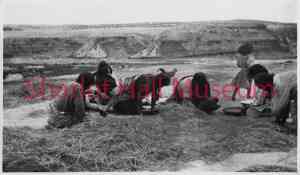Hopi Women Threshing Grain
details
Unknown Unknown inho505p.jpg IN-HO-505 B&W 1502-0505-0000 inho505p Print 8x12 Historic Photographs 1890s Reproduction requires permission. Digital images property of SHM Library & ArchivesDescription
Hopi women threshing grain using baskets.
Threshing is the process of loosening the edible part of grain (or other crop) from the straw to which it is attached. It is the step in grain preparation after reaping. Threshing does not remove the bran from the grain.
Hopi, formerly called Moki or (Spanish) Moqui, the westernmost group of Pueblo Indians, situated in what is now northeastern Arizona. They speak a Northern Uto-Aztecan language.
The precise origin of the Hopi is unknown, although it is thought that they and other Pueblo peoples descended from the Ancestral Pueblo (Anasazi). Archaeology has revealed that some abandoned pueblos, were once occupied by Hopi people.
Traditional Hopi culture emphasizes monogamy and matrilineal descent. Hopi people also practice matrilocal residence, in which a new husband becomes part of his mother-in-law’s household.
The traditional Hopi economy centered on farming and sheep herding. Men farmed and herded, in addition to building houses, performing most of the ceremonies, making moccasins, and weaving garments and blankets. Women made baskets and pottery, cooked, gardened, raised children, and were responsible for providing their families with hand-drawn water.
Young, unmarried women wear a distinctive hairstyle often called a butterfly whorl.
The Hopi are known for their Snake Dance, a religious ceremony praying for rain and good fortune. They are also known for their beautiful pottery, baskets and katsina carvings.
(Source:
https://www.britannica.com/topic/Hopi
The Hopi People, Hopi Cultural Preservation Office, Arcadia Publishing, 2009)
NOTE: Sharlot Hall Museum Research Center has more Hopi photographs; however these are restricted and can only be viewed by approval from the Hopi Cultural Center (email: info@hopiculturalcenter.com or telephone 928-734-2401).
Purchase
To purchase this image please click on the NOTIFY US button and we will contact you with details
The process for online purchase of usage rights to this digital image is under development. To order this image, CLICK HERE to send an email request for details. Refer to the ‘Usage Terms & Conditions’ page for specific information. A signed “Permission for Use” contract must be completed and returned. Written permission from Sharlot Hall Museum is required to publish, display, or reproduce in any form whatsoever, including all types of electronic media including, but not limited to online sources, websites, Facebook Twitter, or eBooks. Digital files of images, text, sound or audio/visual recordings, or moving images remain the property of Sharlot Hall Museum, and may not be copied, modified, redistributed, resold nor deposited with another institution. Sharlot Hall Museum reserves the right to refuse reproduction of any of its materials, and to impose such conditions as it may deem appropriate. For certain scenarios, the price for personal usage of the digital content is minimal; CLICK HERE to download the specific form for personal usage. For additional information, contact the Museum Library & Archives at 928-445-3122 ext. 14 or email: orderdesk@sharlot.org.




